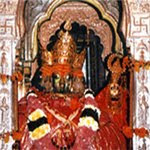All as the apt tribute to Lord Vishnu reveres the five Badris. Badrinath is devoted to the worship of Vishnu who, according to an amusing tale, Usurped this place from Shiva. For Vishnu had come here as the gods once did, to offer penance. He loved the place so much that he plotted to unseat Shiva from his meditation here. He took on the form of a beautiful child and began to wail. Shiva's wife, Parvati picked him up but could not calm the child.
Since his wailing continued to disturb Shiva, he shifted to Kedamath in exasperation, leaving the spot free for Vishnu to occupy. But remainders of Shiva's stay continue to linger, most visibly in the name, badri, a kind of berry that Shiva was S most fond of, and the gigantic tree, invisible to the mortal eye, that served Shiva. Considered one of the Chair Dham or four principal places of Hindu worship, Badrinath's four subsidiary badris include Bhavishya Badri, Yogdhyan Badri,Vridht Badri, and Adi Badri.
Panch Kedar
The five Kedar lies in the valleys between the rivers Bhagirathi and Alaknanda. The term Kedar itself means a natural rock formation or a glacial moraine. According to legend, Kedarnath, the chief seat of the Panch Kedar, come into being during the period when the five Pandava brothers were asked to seek Shiva's blessings, purging them off sin of fratricide, or killing their cousin brothers in the terrifying bettle of Kurukshetra. Shiva disguised himself as a bull and started to plunge underground when he was spotted by Pandavas. No wonder the natural rock formation that is worshipped here resembles the rump of bull. The other four places where Shiva is worshipped take their appearance from different part of his body - the navel at Madmaheshwar, the arm at Tungnath, the face at Rudranath, and the matted hair at Kalpeshwar.
Panch Prayag
Panch Prayag, confluence of most sacred rivers, is considered the epitome of immortal piety. River confluences in India are considered very sacred, especially since rivers themselves are extolled ad goddesses. And outside of Prayag, the great confluence of the Ganga, Yamuna and the mythical Saraswati at Allahabad, the most revered confluences are in the Garhwal Himalayas. Since the two mighty rivers and tributaries trace their source to these mountains, the points at which they meet are sanctified as major pilgrimage centers. It is here that propitiatory and cleansing ceremonies are performed as part of the tenets of Hindu religion. Five Prayags are Vishnu Prayag, Nand Prayag, Karna Prayag, Rudra Prayag and Deo Prayag.
Gangotri
Panch Prayag, confluence of most sacred rivers, is considered the epitome of immortal piety. River confluences in India are considered very sacred, especially since rivers themselves are extolled ad goddesses. And outside of Prayag, the great confluence of the Ganga, Yamuna and the mythical Saraswati at Allahabad, the most revered confluences are in the Garhwal Himalayas. Since the two mighty rivers and tributaries trace their source to these mountains, the points at which they meet are sanctified as major pilgrimage centers. It is here that propitiatory and cleansing ceremonies are performed as part of the tenets of Hindu religion. Five Prayags are Vishnu Prayag, Nand Prayag, Karna Prayag, Rudra Prayag and Deo Prayag.
The shrine of Yamunotri,situated at an elevation of about 3,235 mt is a point of paramount religious importance for Hindus and an essential pilgrimage. Situated in the direction opposite to Gangotri,the road bifurcates froma place called Dharasu,somewhere between Rishikesh- Uttarkashi and goes on to Yamunotri.The shrine can also be visited via mussorie and Barkot.

No comments:
Post a Comment